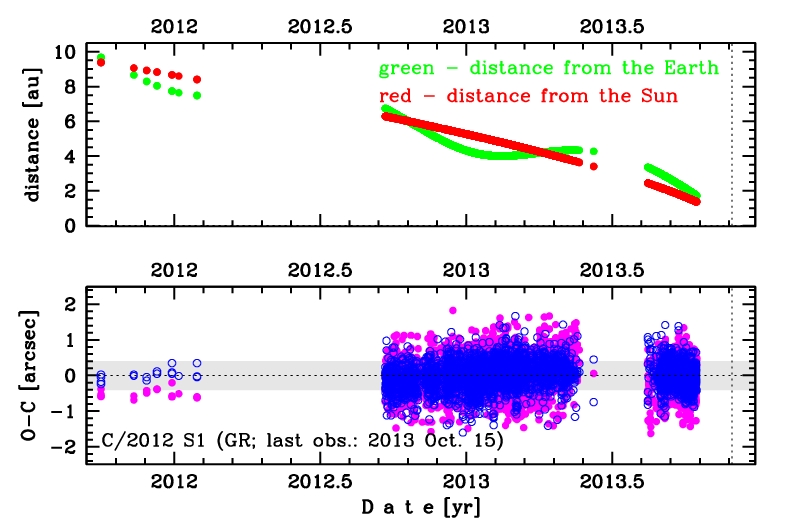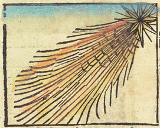C/2012 S1 ISON
(page updated on October 26, 2013)
Current brightness estimates for comet C/2012 S1 ISON are still uncertain. If it becomes significantly brighter than today, rather favorable viewing conditions would allow us to observe it in late November and later in December (see for example our ISON observer guide in Polish).
Over five thousand positional observations of C/2012 S1 have been already made, covering more than two years, so its orbit (current and past) seems to be known rather well.
Since the one of the main goals of our research is to study the past motion of long period comets and their possible origin and source regions we are also calculating its orbit incorporating more and more positional data to analyze its dynamical history.
Basing on 5191 positional observations made up to 2013 Oct. 15 we determined an orbit, which can give us well founded impressions on its origin.
In Figure 1 we plot the structure of the observational material, including geocentric and heliocentric comet distance at any given moment. In the top panel one can find the time distribution of positional observations with corresponding heliocentric and geocentric distance at which they were taken. Horizontal dotted line shows the perihelion distance from the Sun, the moment of perihelion passage is marked with a dashed vertical line near the right border of this plot. Please note several prediscovery observations which are placed 8 months before the discovery on September 21, 2012.
In the bottom panels we present the O-C diagram for pure gravitational solution based on weighted data (for more details on weighting method see our Paper 1). Residuals in right ascension are shown as magenta dots and in declination as blue circles.
Updated orbit of C/2012 S1 ISON
Pure gravitational nominal solution for weighted data (Solution A5-3):
Observational arc: 2011 Sep. 30 — 2013 Oct. 15 Number of observations: 5191 RMS: 0.41 arcsec
Heliocentric osculating orbit
Epoch (TT) 20121128.0 = JD 2456259.5 time of perihelion passage (TT) 20131128.803500 ± 0.000070 perihelion distance 0.01251336 ± 0.00000007 eccentricity 1.00000313 ± 0.00000001 argument of perihelion [deg] 345.502531 ± 0.000029 longitude of the ascending node [deg] 295.747609 ± 0.000040 inclination [deg] 61.802959 ± 0.000229 inverse semimajor axis [10-6 AU-1] -249.80 ± 0.73
Barycentric nominal original orbit (at 250 AU from the Sun), obtained from the above osculating elements
Epoch (TT) 17170608 time of perihelion passage (TT) 20131128.718021 ± 0.000076 perihelion distance 0.01238218 ± 0.00000007 eccentricity 0.99999995 ± 0.00000000 argument of perihelion [deg] 345.524167 ± 0.000030 longitude of the ascending node [deg] 295.769977 ± 0.000040 inclination [deg] 61.800797 ± 0.000230 inverse semimajor axis [10-6 AU-1] 3.90 ± 0.74
Barycentric nominal future orbit (at 250 AU from the Sun), obtained from the above osculating elements
Epoch (TT) 23090913 time of perihelion passage (TT) 20131128.870029 ± 0.000063 perihelion distance 0.01309098 ± 0.00000007 eccentricity 1.00000066 ± 0.00000007 argument of perihelion [deg] 345.659301 ± 0.000029 longitude of the ascending node [deg] 295.724877 ± 0.000038 inclination [deg] 62.165382 ± 0.000226 inverse semimajor axis [10-6 AU-1] -50.79 ± 0.74
Previous solutions: A1-1, A5-1 and A5-2
Dynamical history of C/2012 S1 ISON
Starting from the original orbit presented above, we followed the dynamical evolution of C/2012 S1 ISON under Galactic tides (both disc and central terms were included) and stellar perturbations; for more details see our Paper2.
As it is clearly indicated by 1/aori value presented above, the original orbit of C/2012 S1 ISON is almost perfect parabola. If we follow its motion back to the past we can observe weak perturbations by nearby stars, see Fig.2. The horizontal axis shows the moment of osculation for which orbital elements are calculated and plotted; the zero-point corresponds to the forthcoming perihelion passage. The left vertical axis is expressed in AU and describes both the heliocentric distance of a comet ( r, thin vertical blue lines) and its osculating perihelion distance ( q, continuous, green line). The right vertical axis describes angular elements (with respect to the Galactic frame) and is expressed in degrees. We plot here the evolution of the argument of perihelion (ω, red line), inclination (i, magenta line) and the Galactic latitude of perihelion (b, cyan line). Small irregularities in all curves, visible especially in inclination and perihelion distance curves are caused by weak stellar perturbations. Some of them are marked with arrows, giving the name of the perturbing star.
As you can see none of the known stars have significantly perturbed the orbit of C/2012 S1 ISON recently (i.e. during last several million years), its past orbit points to the deep space as the source of this comet.





